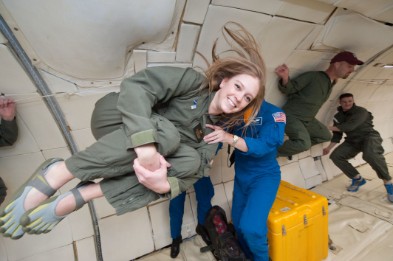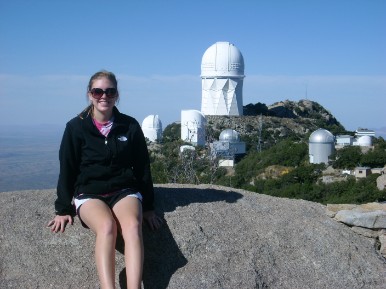Cool Stuff
During the past two years, I've been fortunate to participate in NASA's Reduced Gravity Systems Engineering Educational Discovery (SEED) Program twice.
 photo courtesy: NASA | Since January 2011, myself and a team of 7 other students have been working on a project with Rudy Werlink, a research engineer at Kennedy Space Center. We collaborated on a project to non-invasively measure fluid volume in a tank under variable gravitational environments using Piezo-Electric Transducer (PZT) technology. The PZT sensors function by generating electrical current in response to mechanical motion. In our project, we attached four PZT sensors to a tank with a known volume of water. Using a signal generator to drive a PZT acuator, the model tank is induced to vibrate. The additional PZT sensors detect the tank vibrations. The resulting resonance data will be analyzed using standard techniques of acoustic signal processing, including Transfer Function Analysis. The final goal of the project will be to examine the shift in frequency peaks on graphs to successfully correlate resonance-peak shifts with fluid fill fractions. Our results currently show great potential but will be further analyzed this summer by students. Last year, we collaborated on a project with Jonathan Braun, a propulsion engineer at Lockheed Martin, to develop a scaled model of the propellant tanks of the Orion spacecraft to study the propellant sloshing. |
The highlight of the SEED program involves a flight aboard the Zero-G aircraft. By flying in maneuvers of modified parabolas, the flight simulates an environment of reduced gravity. Not only is the research done awesome, but we also have the opportunity to experience zero-g (weighless), lunar gravity (1/6 G), and martian gravity (1/3 G) and see how our bodies react to the environment. In April 2011 we traveled to Houston for ten days for our flight week. Besides the flight, while in Houston we have many opportunities to tour and explore the area. Some of the places we've toured include the Neutral Buoyancy Lab (NBL), Rocket Park - where the Saturn V is located, Building 9 - which includes a full scaled mock-up of the International Space Station (ISS), and Mission Control Center among others. We've also had the opportunity to meet lots of cool people including Clayton Anderson and Barbara Morgan (astronauts). I personally love talking to people, and since we work in a facility full of NASA employees while there, it's a great experience to walk up to someone and ask what they do or how they got their job. Many have really cool stories. Click here to learn more about the Microgravity University program. Click here to visit a website made to follow our Houston adventures and provide information about the Carthage Microgravity Team. | Video from a GoPro Hero helmet camera placed on our rig during flight. |
During the summer of 2010, I worked on a high altitude balloon payload project under the Wisconsin Space Grant Consortium and Dr. Bill Farrow at Milwaukee School of Engineering.
Video from a GoPro Hero helmet camera attached to the side of the payload. | During the summer of 2010, I worked on the WSGC Elijah High Altitude Project. I worked with 5 other students from across the state of Wisconsin to design, fabricate, build, fly, and recover a high altitude balloon payload. We divided into three sub-teams of two. My partner and I developed a method to take samples of the air for mercury concentration. Being in Wisconsin, we were curious if there would be any correlation between the amounts found in water to the amounts there may be in the air. We launched the balloon west of Madison, WI at the beginning of August, and it traveled 40 miles east and landed in the middle of a corn field (prime corn season too), which made for a fun recovery. A blog and website was created to track the team's progress throughout the summer and outline everything we did. Check it out for photos and more information. |
In October 2010, I traveled to Tucson, Arizona with Professor Arion and four other students to observe at Kitt Peak National Observatory.
While we were there, we observed on the 0.9 meter WIYN telescope. We took images of NGC 891 or Caldwell 23, and NGC 246, the skull nebula. It was super interesting and just as cool to be on top of the mountain and see the sky with the naked eye. Besides learning how the telescope runs and operates, we also got to see the other telescopes at the observatory. I attempted to cook dinner one night for the group, which included spaghetti, and let’s just say it is true that things do not cook the same at high altitudes!
|  |
I have been fortunate to be able to attend many conferences. Recently, I attended the National Space Grant Directors Meeting in Washington, D.C. While there, I got to meet some pretty cool people.
Dr. Neil DeGrasse Tyson - astrophysicist - He has a punch card for how many times he's been a guest on the Colbert Report. | Leland Melvin - astronaut - STS-122 and STS-129 |
 Jeff Hoffman - astronaut - helped fix the Hubble Space Telescope |  John Mather - Nobel Prize Winner for physics in 2006. |